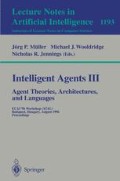Abstract
The advent of software agents gave rise to much discussion of just what such an agent is, and of how they differ from programs in general. Here we propose a formal definition of an autonomous agent which clearly distinguishes a software agent from just any program. We also offer the beginnings of a natural kinds taxonomy of autonomous agents, and discuss possibilities for further classification. Finally, we discuss subagents and multiagent systems.
Preview
Unable to display preview. Download preview PDF.
References
David Ackley and Michael Littman. Interactions Between Learning and Evolution. In Christopher Langton et al., ed., Artificial Life II. Addison-Wesley 407–509, 1992.
Rodney A. Brooks. Elephants Don't Play Chess. In Pattie Maes, ed., Designing Autonomous Agents. MIT Press, 1990.
Jose C. Brustoloni. Autonomous Agents: Characterization and Requirements. Carnegie Mellon Technical Report CMU-CS-91-204, Carnegie Mellon University 1991.
Vincent G. Dethie. The Magic of Metamorphosis: Nature's Own Sleight of Hand. Smithsonian, (17): 122 ff, 1986.
Oren Etzioni and Daniel Weld. A Softbot-Based Interface to the Internet. Communications of the ACM, (37) 7: 72–79, 1994.
Stan Franklin. Artificial Minds. MIT Press, 1995.
B. Hayes-Roth. An Architecture for Adaptive Intelligent Systems. Artificial Intelligence: Special Issue on Agents and Interactivity, (72): 329–365, 1995.
H. Kautz, B. Selman, and M. Coen. Bottom-up Design of Software Agents. Communications of the ACM, (37) 7: 143–146, 1994.
F. C. Keil. Concepts, Kinds, and Cognitive Development. MIT Press,1989.
Christopher Langton, ed. Artificial Life. Addison-Wesley, 1989.
Michael Luck and Mark D'Inverno. A Formal Framework for Agency and Autonomy, Proceedings of the International Converence on Multiagent Systems. 254–260, 1995.
Pattie Maes. How to do the right thing. Connection Science. (1):3.1990.
Pattie Maes, ed. Designing Autonomous Agents, MIT Press, 1991.
Pattie Maes. Artificial Life Meets Entertainment: Life like Autonomous Agents. Communications of the ACM. (38):11, 108–114, 1995.
Marvin Minsky. The Society of Mind. Simon and Schuster. 1985.
J. P. Müller, M. Pischel, and M. Thiel. Modeling Reactive Behaviour in Vertically Layered Agent Architectures. in Wooldridge and Jennings eds. Intelligent Agents. Springer-Verlag, 261–276, 1995.
Stuart J. Russell and Peter Norvig. Artificial Intelligence: A Modern Approach. Prentice Hall, 1995.
D. C. Smith, A. Cypher and J. Spohrer. KidSim: Programming Agents Without a Programming Language. Communications of the ACM, (37): 7, 55–67, 1994.
Hongjun Song, Stan Franklin and Aregahegn Negatu. SUMPY: A Fuzzy Software Agent. in ed. F. C. Harris, Jr., Intelligent Systems: Proceedings of the ISCA 5th International Conference (Reno Nevada, June 1996) International Society for Computers and Their Applications — ISCA, 124–129. 1996.
Michael Woolbridge and Nicholas R. Jennings. Agent Theories, Architectures, and Languages: a Survey. in Wooldridge and Jennings eds. Intelligent Agents. Springer-Verlag, 1–22, 1995.
Author information
Authors and Affiliations
Editor information
Rights and permissions
Copyright information
© 1997 Springer-Verlag Berlin Heidelberg
About this paper
Cite this paper
Franklin, S., Graesser, A. (1997). Is It an agent, or just a program?: A taxonomy for autonomous agents. In: Müller, J.P., Wooldridge, M.J., Jennings, N.R. (eds) Intelligent Agents III Agent Theories, Architectures, and Languages. ATAL 1996. Lecture Notes in Computer Science, vol 1193. Springer, Berlin, Heidelberg. https://doi.org/10.1007/BFb0013570
Download citation
DOI: https://doi.org/10.1007/BFb0013570
Published:
Publisher Name: Springer, Berlin, Heidelberg
Print ISBN: 978-3-540-62507-0
Online ISBN: 978-3-540-68057-4
eBook Packages: Springer Book Archive

